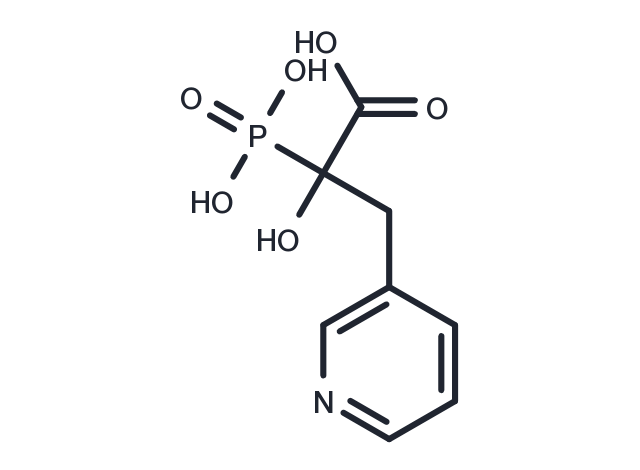Powder: -20°C for 3 years | In solvent: -80°C for 1 year


NE 10790 (3-PEHPC) is a phosphonocarboxylate analogue of the potent bisphosphonate risedronate and is a weak anti-resorptive agent. Although NE10790 was a poor inhibitor of FPP synthase

| Pack Size | Availability | Price/USD | Quantity |
|---|---|---|---|
| 1 mg | In stock | $ 108.00 | |
| 5 mg | In stock | $ 228.00 | |
| 10 mg | In stock | $ 372.00 | |
| 25 mg | In stock | $ 629.00 | |
| 50 mg | In stock | $ 896.00 | |
| 100 mg | In stock | $ 1,220.00 |


| Description | NE 10790 (3-PEHPC) is a phosphonocarboxylate analogue of the potent bisphosphonate risedronate and is a weak anti-resorptive agent. Although NE10790 was a poor inhibitor of FPP synthase |
| In vitro | NE 10790 did inhibit prenylation in J774 macrophages and osteoclasts, but only of proteins of molecular mass approximately 22-26 kDa, the prenylation of which was not affected by peptidomimetic inhibitors of either farnesyl transferase (FTI-277) or geranylgeranyl transferase I (GGTI-298).?These 22-26-kDa proteins were shown to be geranylgeranylated by labelling J774 cells with [(3)H]geranylgeraniol.?Furthermore, NE10790 inhibited incorporation of [(14)C]mevalonic acid into Rab6, but not into H-Ras or Rap1, proteins that are modified by FTase and GGTase I, respectively.?These data demonstrate that NE10790 selectively prevents Rab prenylation in intact cells.?In accord, NE10790 inhibited the activity of recombinant Rab GGTase in vitro, but did not affect the activity of recombinant FTase or GGTase I. NE10790 therefore appears to be the first specific inhibitor of Rab GGTase to be identified.?In contrast to risedronate, NE10790 inhibited bone resorption in vitro without markedly affecting osteoclast number or the F-actin 'ring' structure in polarized osteoclasts.?However, NE10790 did alter osteoclast morphology, causing the formation of large intracellular vacuoles and protrusion of the basolateral membrane into large, 'domed' structures that lacked microvilli.?The anti-resorptive activity of NE10790 is thus likely due to disruption of Rab-dependent intracellular membrane trafficking in osteoclasts[1]. |
| Synonyms | 3-PEHPC |
| Molecular Weight | 247.14 |
| Formula | C8H10NO6P |
| CAS No. | 152831-36-2 |
Powder: -20°C for 3 years | In solvent: -80°C for 1 year
H2O: 5 mg/mL (20.23 mM), when pH is adjusted to 6 with NaOH. Sonication is recommended.
DMSO: < 1mg/ml (insoluble)
You can also refer to dose conversion for different animals. More
bottom
Please see Inhibitor Handling Instructions for more frequently ask questions. Topics include: how to prepare stock solutions, how to store products, and cautions on cell-based assays & animal experiments, etc.
NE 10790 152831-36-2 Others inhibit 3-PEHPC NE10790 Inhibitor NE-10790 inhibitor
